Michael Wittmann |
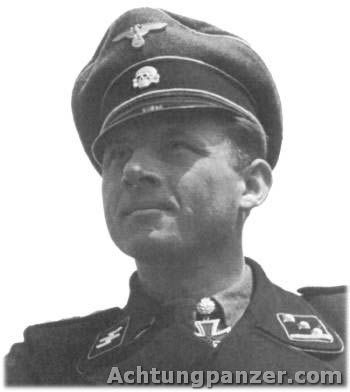 |
SS-Obergruppenfuhrer Josef "Sepp" Dietrich after Wittmann's death.
In October of 1939, Michael Wittmann joined the 5th Panzerspähkompanie (the depot company of the Leibstandarte) based at Berlin (Lichterfelde), which was an assault gun "academy". In February of 1940, Wittmann was transferred to the newly formed SS-Sturm-Batterie (assault gun battery - Sturmartillerie) of LSSAH, equipped with Sturmgeschutz Ausf A assault guns.The reason for his transfer was that Wittmann held a rank below officer with three years of service and experience on an armored vehicle.At the same time, Wittmann became friends with Hannes Philipsen, Helmut Wendorff, Alfred Günther and other members of that unit. In late 1940, Michael Wittmann started his true panzer combat career in the Balkans (Yugoslavia and Greece). While in Greece, Wittmann was in command of the platoon of Sturmgeschutz III Ausf As (part of LSSAH SS-Sturm-Batterie) and fought there until mid 1941.
On June 11th of 1941, Wittmann along with LSSAH was transferred to the east, in preparations for the upcoming operation "Barbarossa", which started on June 22nd. LSSAH was ordered to advance into southern Russia. On July 12th of 1941, Michael Wittmann received an Iron Cross (Second Class) for destruction of Soviet tanks. Some time later, Wittmann was wounded in combat, but remained with his unit and received the Wound Badge. On September 8th of 1941, he received Iron Cross (First Class) followed after fighting in the Rostov area by the Panzer Assault Badge (for destroying six Soviet tanks in single engagement). Wittmann was also promoted to the rank of SS-Oberscharführer. Until June of 1942, Wittmann fought with his unit in Russia.On June 5th of 1942, because of his outstanding service Wittmann was accepted as a cadet for the officer training in the SS Junkerschule in Bad Tölz (Bavaria).On September 5th of 1942, Wittmann left Bad Tölz school as a Panzer instructor (SS-Panzerausbildungs und Ersatz-Abteilung).
In Autumn of 1942, 1st Waffen-SS Motorized Division "Leibstandarte SS Adolf Hitler" was upgraded to the status of a Panzer-Grenadier Division. Also additional 13th Kompanie was equipped with PzKpfw VI Tiger. Training took place at Padeborn in Germany and then at Ploermel in France.In the end of January of 1943, "Leibstandarte SS Adolf Hitler" was transferred to the Eastern Front. The command of the 13th Kompanie was given to SS-Haupsturmfuhrer Heinz Kling.
On December 21st of 1942, Wittmann was promoted to the rank of SS-Untersturmführer and on December 24th, he joined the 13th Kompanie of Leibstandarte SS Adolf Hitler. Michael Wittmann was put in the command of Panzer III Ausf L/M platoon of Tiger company. The platoon was designated to protect the back line of the Tigers from enemy infantry and other obstacles. In the early spring of 1943, Michael Wittmann joined the Tiger company, and left his Panzer III support section. On July 5th of 1943, Wittmann started his combat career on Tiger during the Operation Citadel (Zitadelle). LSSAH was located in the southern sector of the bulge.On the first day of action, Wittmann destroyed two anti-tanks guns and thirteen T-34s, while saving Helmut Wendorff's platoon, which run into trouble. On July 7th and 8th, Wittmann destroyed two T-34s, two SU-122s and three T-60/70s. On July 12th, Wittmann destroyed eight Soviet tanks, three anti-tank guns and one gun battery. This operation finished on the 17th of July 1943, and included the battle of Kharkov and Kursk along with other engagements. During that time Wittmann's Tiger destroyed 30 Soviet tanks along with 28 guns. On July 29th of 1943, 13th company was used to form schwere SS Panzer Abteilungen 101, which was then attached to LSSAH. In August of 1943, LSSAH was transferred to Italy, for refitting and occupational duties.
In October of 1943, 1st SS-Panzer-Grenadier-Division "Leibstandarte SS Adolf Hitler" was reorganized as 1st SS Panzer Division "Leibstandarte SS Adolf Hitler".
In sSSPzAbt 101, Wittmann (Tiger #1331) served with other Tiger Aces like: Franz Staudegger (Tiger#1325), Helmut Wendorff (Tiger #1321) and Jürgen Brandt (Tiger #1334). The command of this unit was given to SS-Haupsturmfuhrer Heinz Kling (Tiger #1301). In October of 1943, after the start of Soviet Autumn Offensive, LSSAH was transferred back to the Eastern Front (Kiev area). Also in October, Wittmann changed his Tiger #1331 for the Tiger #S21 and got under his command Jürgen Brandt (Tiger #S24). On October 13th, Wittmann's Tiger destroyed twenty T-34s along with twenty three infantry and anti-tank guns.In December, Wittmann took part in numerous engagements and destroyed a number of Soviet tanks and guns.
On January 13th of 1944, Michael Wittmann received the Knight's Cross for his outstanding service to the Fatherland. "From July of 1943 to the beginning of January 1944 he has destroyed 56 enemy AFVs, including T 34s and super heavy SPs. On 8 and 9 January he and his platoon halted and destroyed breakthrough attempts of a Soviet tank Brigade, and in that battle he destroyed a further ten vehicles. On January 13, nineteen T 34s and three super-heavy SP guns. His total then stood at 88 tanks and SPs." - German radio annoucement, January 13th of 1944. On January 15/16th of 1944, SS-Rottenfuhrer Balthasar (Bobby) Woll received his Knight's Cross. Balthasar Woll was an excellent gunner, who was even able to fire accurately while on the move.
On January 20th, Wittmann was promoted to the rank of SS-Obersturmfuhrer.Two weeks later, on January 30th 1944, Wittmann received following telegram from Adolf Hitler himself: "In thankful appreciation of your heroic actions in the battle for the future of our people, I award you as the 380th soldier of the German Wehrmacht, the Oakleaves to the Knight's Cross of the Iron Cross. Adolf Hitler.". On February 2nd of 1944, Wittmann received Oak Leafs to his Knights Cross from Führer's hands, in "Führerhauptquartier Wolfsschanze" (Wolfslair - Rastenburg in East Prussia).
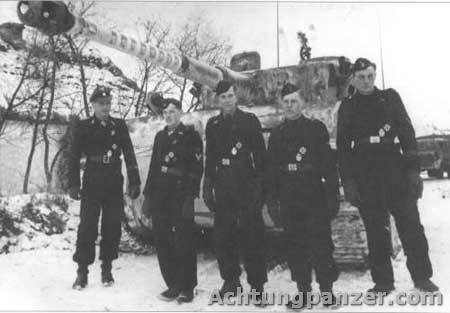 |
Wittmann's Tiger S04 and his crew (left to right):
SS-Untersturmführer Michael Wittmann,
SS-Rottenführer Bobby Woll,
SS-Panzerchütze Werner Irrgang,
SS-Panzerschütze Sepp Rössner and
SS-Sturmmann Eugen Schmidt.
The 88 white rings (kills) were painted for the occasion and the picture was taken by SS-Büschel (Propaganda Kompanie - PK). On the February 28th of 1944, Wittmann's unit, which was under the command ofSS-Hauptsturmführer Heinz Kling, counted five Iron Cross "Knights":SS-Untersturmführer Staudegger, SS-Untersturmführer Wendorf andSS-Hauptsturmführer Kling.SS-Obersturmführer Wittmann was the only one with Oak Leafs to his Knights Cross.During the period from February 29th to March 2nd of 1944, the larger part of the company was transferred to Mons in Belgium. At the time of the transfer, Wittmann received the command of 2nd Kompanie of sSSPzAbt 101 of LSSAH. After leaving Eastern Front, Michael Wittmann stated that the Soviet anti-tank guns were harder and were more prized targets than tanks. On March 1st, Michael Wittmann married Hildegard Burmester and his marriage witness was his gunner - Balthazar (Bobby) Woll.
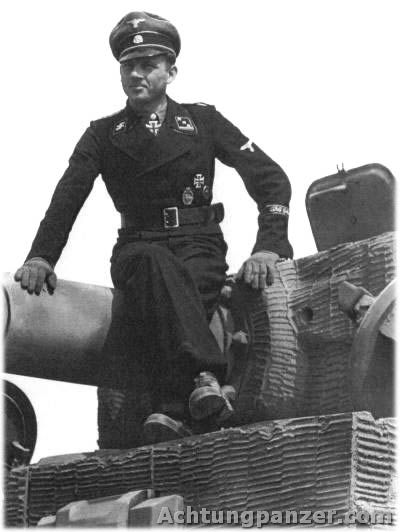 |
At that time, Wittmann became a national hero and was seen everywhere. The propaganda made him into a hero of the entire German nation. In the April of 1944, Wittmann visited the Henschel und Sohn factory at Kassel and spoke to the employees thanking them for their great job on producing Tiger I. During his visit he discovered the production line of Late Type Tiger I Ausf E. In May of 1944, Wittmann re-joined the sSSPzAbt 101 of the LSSAH, which was stationed in the area of Lisieux in Normandy, France.
At the time, Bobby Woll (holder of Iron Cross 1st and 2nd Class and Knight's Cross) received a command of a Tiger and took part in the Normandy battles, where he was wounded (during an air attack) and remained in a hospital until March of 1945. He returned to active service and took part in the final battles on the Western Front. Woll survived the war and became an electrician. He died in 1996.
LSSAH was a part of panzer reserve, which included 12th SS Panzer Division "Hitlerjugend" and the Panzer Lehr Division. At that time the command of sSSPzAbt 101 was given to Heinz von Westernhagen (Tiger #007), while the 1st Kompanie was commanded by Hauptsturmfuhrer Mobius. On the June 6th of 1944 (D-Day), Wittmann got a new late production model Tiger I #205. From 6th to 12th June, sSSPzAbt 101 moved to the invasion front in Normandy. On their way, Wittmann's 2nd Kompanie was reduced to six Tigers by Allied air attacks. Wittmann's company along with the Panzer Lehr Division and the 12th SS Panzer Division "Hitlerjugend" was part of Heeresgruppe under the command of Erwin Rommel. On June 13th, the battle began near Bayeux area. At the time Wittmann's company was near Villiers-Bocage, at the south of Tilly-sur-Seulles (Caen area). On June 13th of 1944, Wittmann's company destroyed entire 4th County of London Yeomanry Regiment travelling on the road No.175 to Villers-Bocage, at the Hill No.213.
On 13th June 1944, a week after D-day, following a drive from Beauvais under repeated air attack, 2nd Kompanie of sSSPzAbt 101 led by Michael Wittmann had 6 Tigers located in the area of Hill (Point) 213 ahove Villers Bocage. His orders were to stop the advance of the 22nd Armored Brigade of the British 7th Armored Division (the famous 'Desert Rats') from advancing through the township, outflanking the German line and gaining the road to Caen. Wittmann's company hidden behind a hedgerow spotted the enemy column, which passed him at a distance of 200 meters. At about 8:00am, Wittmann attacked the British column on the main road, while the rest of his company (4 Tigers as one brokedown) attacked the British forces around Hill 213. Soon after, Wittmann destroyed Sherman Firefly and Cromwell IV and headed south to attack the rest of the enemy transport column. After knocking out 8 half-tracks, 4 Bren Carriers and 2 6 pdr anti-tank guns, Wittmann reached the crossroad with the road to Tilly-sur-Seulles. At the crossroad, he destroyed 3 Stuart tanks from recon unit and reached the outskirts of the town of Villers-Bocage. While in town, Wittmann destroyed 4 Cromwell IV tanks and single half-track and turns into Rue Pasteur. Following up the street, he knocked out Cromwell IV and Sherman OP tank, reaching the main street of Villers-Bocage. At the end of Rue Pasteur, Wittmann's Tiger was hit by Sherman Firefly from B Squadron and he decided to turn back as being too far forward without any infantry support and in a build-up area. He turned in the direction of Caen to join the rest of his company. On his way back, Wittmann's Tiger was attacked by another Cromwell IV, which he destroyed as well. Back at the Tilly crossroad, British soldiers from 1st Rifle Brigade opened fire at Wittmann with their 6 pdr anti-tank gun, immobilizing his Tiger. Wittmann and his crew managed to escape on foot towards the Panzer Lehr positions 7km away near Orbois. The rest of his company at the Hill 213, destroyed the rest of the A Squadron of 4th County of London Yeomanry Regiment ("Sharpshooters") including 5 Cromwell IV and Sherman Firefly, while capturing 30 men. During this short engagement, Wittmann's company destroyed 4 Sherman Firefly, 20 Cromwell, 3 Stuart, 3 M4 Sherman OP, 14 half-tracks, 16 Bren Carriers and 2 6 pdr anti-tank guns. Wittmann's attack was followed by another one by Tigers of Hauptsturmfuehrer Rolf Moebius' 1st Kompanie of sSSPzAbt 101 and Panzerkampfwagen IV tanks from Panzer Lehr but was repulsed by anti-tank guns from 22nd Armored Brigade. Following day, British withdrew from the town leaving it to the Germans, who occupied it for next two months. The British drive on Villers Bocage and Caen was stopped cold by Wittmann's attack and following actions.
On July 22nd, after his success at Villers-Bocage, Wittmann received the Swords for his Knight Cross with Oak Leafs after being recommended personally by the LSSAH's commander, SS-Obergruppenfuhrer und Panzergeneral der Waffen SS Josef "Sepp" Dietrich. The ceremony was on June 25th of 1944 and Adolf Hitler in person decorated Wittmann who then became the most decorated tanker ace of World War II.
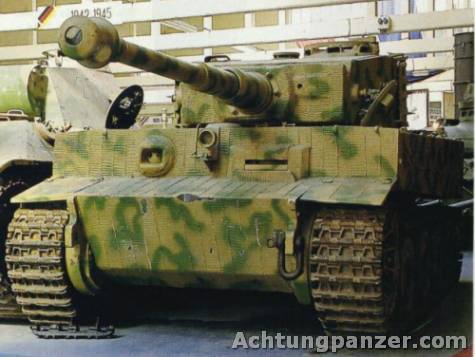 |
At the same time he also received the rank of SS-Haupsturmfuhrer. Wittmann was offered a position of an instructor at a training schoolbut he refused and returned to Normandy on July 6th and participated in the Battle of Caen (3rd to 10th of July). During July of 1944, Wittmann fought near Caen area until August. At the time Wittmann got a new Tiger #007. In the beginning of August, Wittmann along with sSSPzAbt 101 was transferred to Cintheaux area. At the time Germans tried to recapture Caen which was completely destroyed by ongoing fighting. On August 8th of 1944, a new battle began near Cintheaux. It was Wittmann's final battle. At 12:55am (as reported by SS-Hauptscharführer Höflinger - Tiger #213 which was positioned in the same field at the rear, right of Wittmann's Tiger) in a field near the road to Caen-Cintheaux, at Gaumesnil, Wittmann's Tiger was destroyed and its entire crew killed. After fighting the remains of Wittmann and his crew were buried beside what was left of their Tiger, without any markings.
Until 1983, the destruction of Wittmann's Tiger was an mystery even for crews of sSSPzAbt 101. Many sources say that it was destroyed by the "Firefly Ambush", but different units claimed to ambush and destroy Wittmann's Tiger, including those of the either 1st Polish Armored Division, 4th Canadian Armored Division (Canadian Shermans supposedly surrounded and shot Wittmann's Tiger to pieces) or 33rd British Independent Armored Brigade. In the memoirs of a former member Mr.F.R of sSSPzAbt 101, official version at the time stated that Wittmann's Tiger was destroyed by an airplane bomb. Both presented a picture of Wittmann's Tiger without its turret with the gun barrel placed on the hull which in fact is the picture of SS-Untersturmführer Alfred Günther's Tiger from 3rd Kompanie of sSSPzAbt 101 of destroyed by an airplane bomb at Evrecy. Along with those two versions, some claims were made that units, which were not even present in the area at the time, were responsible for destroying Wittmann's Tiger. In 1945, Mr.Serge Varin found Tiger #007. Mr.Varin was interested in this tank because its turret was teared away from the hull. Mr.Varin examined Wittmann's Tiger and noticed that it was not penetrated by any shells fired at it during the fighting. The only damage to the hull was a big hole in the rear, near the engine deck.
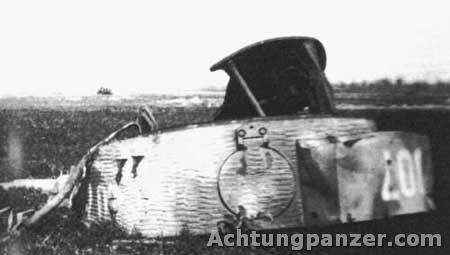 |
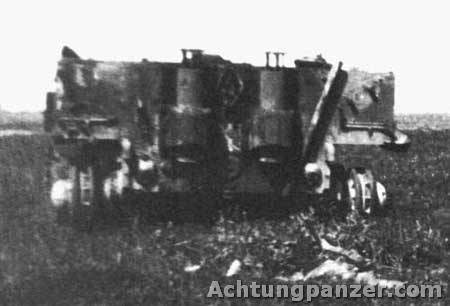 |
After further examination Mr.Varin concluded that the impact came from the air. The rocket hit Tiger's rear deck (made of 25mm thick armor), penetrated the air intakes and exploded causing the explosion in the engine compartment and fighting compartment which ignited the stored ammunition. The second explosion instantly killed the entire crew and blew off the turret into the air. According to Varin, Wittmann's Tiger was destroyed by a rocket fired from a Royal Air Force Hawker "Typhoon" MkIB - attack aircraft. Typhoons were armed with HE (High-explosive) rockets and took heavy tow of German tanks during the Normandy battles (for example on August 8th of 1944, Typhoons destroyed 135 German tanks and among those Tiger #007).
Finally, it was proven that Wittmann's Tiger was destroyed by fire from tanks of "A" Squadron of Northamptonshire Yeomanry. British Firefly crew observed advancing Tigers and opened fire at when Tigers were some 800m away. According to original War Diary of "A" Squadron, at 12:20, 3 Tigers were moving towards the Squadron and were destroyed at 12:40, 12:47 and 12:52 without any losses. After the first Tiger was destroyed at 12:40, second one returned fire but was hit and blew up in a loud explosion. Following that, third Tiger was knocked out after receiving two hits. Wittmann's Tiger was destroyed as second at 12:47 by British Sherman VC "Firefly" commanded by Sergeant Gordon (gunner - Trooper Joe Ekins) from 3rd Platoon, "A" Squadron, 33rd Armored Brigade of 1st Northamptonshire Yeomanry. British Sherman VC "Firefly" armed with 17 pounder gun was capable of penetrating Tiger's armor at range of 800m. The force of explosion blew off the turret, which landed upside down away from the hull. Wittmann did not know that British had Firefly in the area and felt confident in attacking their position with his Tigers, otherwise he would take different approach to the whole attack. Another version is that Wittmann was killed by fire from a Canadian regiment, the Sherbrooke Fusiliers. After Wittmann failed to return from the battle, search for him by the members of the 12th SS Panzer Division "Hitlerjugend" and his battalion took place during the day and on the night of 8/9th.
Michael Wittmann and his crew was killed in action on August 8th of 1944, at Gaumesnil near Cintheaux and were buried in an unmarked grave. In March of 1983, the unmarked field grave of Tiger #007's crew was discovered during the construction of the road and was excavated. It was possible to identify the remains by Wittmann's dental records and Heinrich Reimers's (driver) identification tag. Wittmann and his crew was then officially buried in the German Military Cemetery of "De La Cambe" in Normandy, France. The cemetery is located on the National Road 13 (RN 13) between Isigny-sur-Mer and Bayeux. Michael Wittmann is buried in square 47, row 3, grave 120 of "De La Cambe". On August 8th of 1944, crew of Tiger #007 from 2nd Kompanie of schwere SS-Panzer Abteilungen 101 of LSSAH was as follows:
SS-Sturmmann Rudolf "Rudi" Hirschel (radioman) 24/1/3 - 44/8/8 (20 years old),
SS-Unterscharführer Henrich Reimers (driver) 24/5/11 - 44/8/8 (20 years old),
SS-Unterscharführer Karl Wagner (observer) 20/5/31 - 44/8/8 (24 years old),
SS-Sturmmann Günther Weber (loader) 24/12/21 - 44/8/8 (20 years old),
SS-Haupsturmfuhrer Michael Wittmann (commander) 14/4/22 - 44/8/8 (30 years old).
He ended up his career as a Commander of 2.Kompanie schwere SS-Panzer Abteilung 101 (part of 1st SS Panzer Division "LSSAH").SS-Haupsturmfuhrer Michael Wittmann was the most successful tanker ace of World War II. His friends said that Michael Wittmann was quiet man even during combat and that he had 6th sense, to know where and how to engage the enemy. Wittmann commanded excellent crews, who were able to fully cooperate withhim and anticipated his orders.
Wittmann was highly admired by his comrades and very highly thought of by his superiors. Michael Wittmann represents a real hero who fought to the bitter end for his Fatherland. Wittmann's personal bravery is unquestionable and his place in the annals of military history thoroughly deserved.
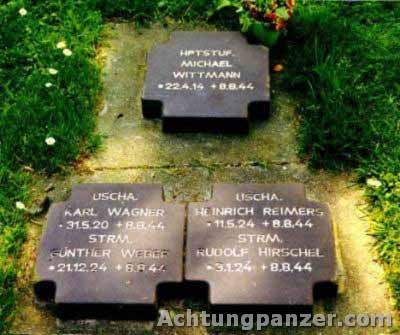 |
Picture provided by Eric Peytavin.
- Born: 22 April 1914 in Vogelthal/Oberplatz.
- Combat Service:
- Poland (1939),
- Balkans (1940/41),
- Eastern Front (1941-1944),
- Normandy (1944). - Awards:
- Iron Cross 2nd and 1st Class (EK II and EK I),
- Knights Cross (Ritterkreuz),
- Oakleaves to the Knights Cross (Eichenlaub),
- Swords to the Knights Cross (Schwerter). - Total victories (kills):
- 141 tanks,
- 132 antitank guns.
* Most of this score was tailed on the Eastern Front. - Died: Killed in action on August 8, 1944, around Cintheaux Gaumesnil near Caen, France.
- Buried:De La Cambe, France - German Military Cemetery.
No comments:
Post a Comment